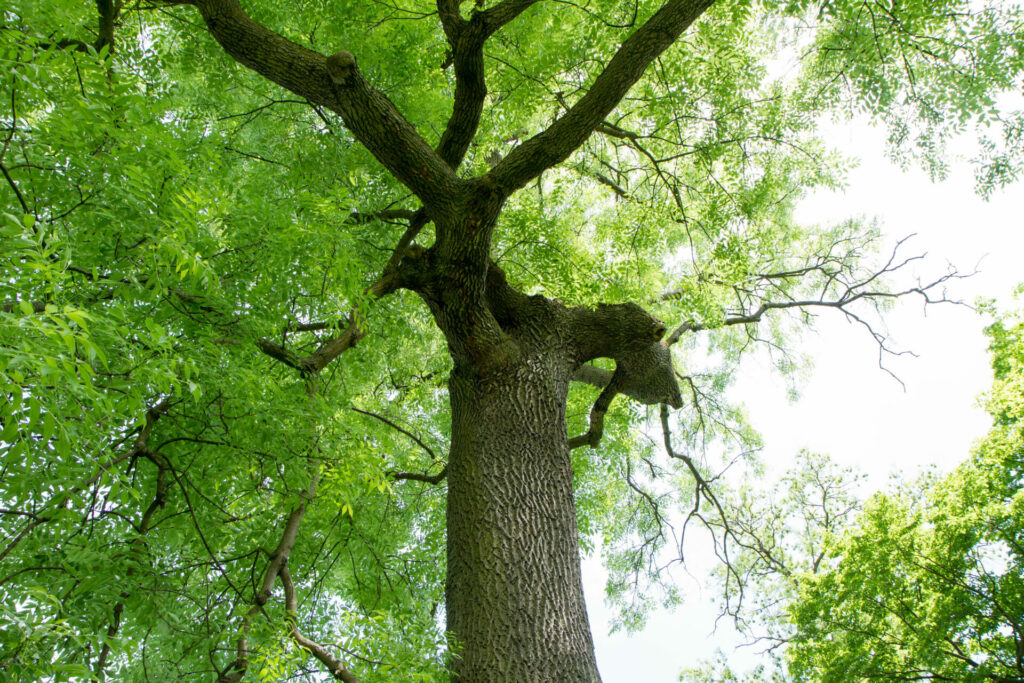Ash trees are susceptible to infestation by the Emerald Ash Borer (EAB), an invasive insect species. EAB larvae feed on the inner bark, creating galleries that eventually girdle the tree, leading to branch dieback and canopy decline. As the infection spreads, the tree becomes more susceptible to secondary pests and diseases. If not treated, its defenses will deteriorate and eventually die.
Identifying the signs and symptoms of EAB infestation is essential for timely intervention. Join us as we investigate common damage indicators and various EAB injection treatments to protect your ash trees!
Common Symptoms of EAB Infestations
The following symptoms indicate a high likelihood of an EAB infestation:
Thinning Canopy
One visible indicator of an EAB problem is the thinning of the tree’s canopy. The borers disrupt the tree’s vascular system by tunneling under the bark, impeding the flow of water and nutrients and producing fewer leaves. This results in a sparse canopy with noticeable gaps between branches.
Epicormic Sprouting
Ash trees may exhibit epicormic sprouting in response to the stress caused by an EAB infestation. Epicormic sprouting refers to the new shoots that emerge from dormant buds along the trunk and branches of the tree. It’s also the tree’s attempt to compensate for the loss of foliage caused by EAB feeding.
D-Shaped Exit Holes
Adult borers emerge from infested trees by chewing their way out through the bark, leaving distinctive D-shaped exit holes behind. These holes are approximately 1/8-inch in diameter and are usually clustered together on the trunk, branches, and sometimes even on exposed roots.
Vertical Splits in Bark
As EAB larvae dig beneath the bark, they stress the tree’s trunk and branches, causing vertical fractures or fissures. These splits may vary in size and severity but are commonly observed in areas where the larvae are active. They can significantly weaken the tree’s structure and make it more susceptible to further damage from wind and storms.
Dieback of Branches
Infested ash trees may exhibit dieback of branches, where canopy sections begin to wilt, turn yellow, or die off prematurely. This occurs because of nutrient deprivation caused by EAB feeding. As the borers disrupt the flow of water and nutrients, affected branches gradually lose their vitality and succumb to infestation.
Types of EAB Injection Treatments
The EAB injection treatments listed below are direct application procedures that target infestations by administering the solution into the tree’s vascular system:
Systemic Insecticides
Systemic insecticides are chemicals absorbed and transported within a tree’s vascular system, allowing them to circulate throughout the tissues. They offer long-lasting protection, as the substance remains active within the tree for an extended period. Additionally, they reduce environmental exposure, as they are contained within the treated tree and do not pose a risk to non-target organisms.
Biological Control Agents
Parasitoid wasps and predatory beetles are EAB’s natural enemies and can be introduced directly into the environment as biological control agents. They are injected into the area through release programs or strategically placing them where EAB populations are present. This approach establishes a sustainable balance between EAB and its natural enemies.
Integrated Pest Management
IPM involves using multiple control methods — including chemical, biological, and physical controls — to manage pest populations. For EAB treatment, it may include the use of systemic insecticides, biological control agents, tree removal, and other strategies. This method is an ecologically sustainable approach to pest management that seeks to minimize the reliance on chemical pesticides.
Get Expert EAB Treatment From Well Rooted Gardens!
Looking for expert guidance on EAB injection treatment? Well Rooted Gardens has you covered! Our team specializes in preserving ash trees and combating EAB damage.
Using a direct injection system, we deliver a patented insecticide into the cambium layer of the tree, offering 2 years of protection. Much less intrusive than old methods of drilling into the wood, this system uses surgical-sized needles for minimal damage to the tree. The product is also designed to be less harmful to pollinators.
Whether you need preventative treatment or intervention for existing infestations, we’re here to help! Call us at 402-800-7389.

